The End-User Help Desk In IT Services
By Jeff Connolly, TSIA

How are other IT providers supporting end user populations today? Is providing end user support critical to the future success of your business?
VARs and MSPs are often asked to support end users as part of their service portfolio, but delivering this function is sometimes a challenge for organizations without existing or scalable end user support capabilities. Some providers embrace this function, while others shy away. What should you be considering when adding this capability to your portfolio?
To help examine the challenges and opportunities in supporting an “End-User Help Desk” capability, TSIA recently completed a short poll of our members about their support of end users in managed services. Before we look at the results, let’s take a moment to get on the same page about the use of some common, and commonly confusing, terminology related to the use of “Service Desk” and “End-User Help Desk”.
What Are End-User Help Desk Services?
In IT businesses today, our touchstone resource for process and function definitions is the ITIL (Information Technology Infrastructure Library) framework, utilized by 86 percent of the managed services organizations that TSIA has benchmarked. However, ITIL is entirely silent on the term “Help Desk” but does provide significant detail about the practice of a “Service Desk”. The ITIL Foundation (ITIL 4 Edition, section 5.2.13) defines Service Desk as the following:
The purpose of the service desk practice is to capture demand for incident resolution and service requests. It should also be the entry point and single point of contact for the service provider with all of its users.
ITIL Foundation
In the context of a Service Desk, users are any population that have been granted authority to access that resource. This access may be defined broadly or narrowly under ITIL.
So, ITIL is silent both in regard to the term “Help Desk” and the differentiation between “Service Desk” support for end users versus any other type of users (administrative, IT, business unit, “authorized user”, etc.). However, in practice, we know that supporting managed services to an entire end user population is quite a different practice than delivering to select users within an IT organization.
Many managed service providers see providing support to a population of relatively uninformed and untrained end users as being extremely costly, less scalable, less valuable and, overall, a significant burden when compared to supporting a much smaller number of IT users or business unit leadership. Sometimes this view is based on history—many Managed Services organizations have grown up out of the Support Services organization of a company, whose primary role had been supporting a technology (hardware, software, platform) through the delivery of services to fellow technologists (the IT organization).
To clarify the use of the term, at TSIA, we define the practice of providing Service Desk support to an end user population as “End-User Help Desk” services. These services may be provided within the same ITIL-defined “Service Desk” delivery organization or may be a separate delivery entity altogether.
What Functions Does an End-User Help Desk Provide?
Per the definition above, if an End-User Help Desk is a Service Desk supporting an end user population, then it provides the same Service Desk services as defined by ITIL, just with different characteristics as influenced by its different, larger, end user population. From our TSIA report, “Defining Managed Services”:
"The core functional responsibilities of the Service Desk include:
- Logging incidents and requests
- Level 1 issue identification and resolution
- Managing and escalating incidents and problems (also known as trouble tickets)
- Informing clients of the status of incidents, problems, and change requests
When supporting end user populations, the volume of work performed under the banner of service requests (“Request Fulfillment Management” under ITL v3 now called “Service Request Management” under ITIL v4) becomes a much larger portion of services rendered. These requests include (from ITIL Foundation v4):
- A request for a service delivery action (for example, providing a report or replacing a toner cartridge)
- A request for information (for example, how to create a document or what the hours of the office are)
- A request for provision of a resource or service (for example, providing a phone or laptop to a user, or providing a virtual server for a development team)
- A request for access to a resource or service (for example, providing access to a file or folder)
- Feedback, compliments, and complaints (for example, complaints about a new interface or compliments to a support team)"
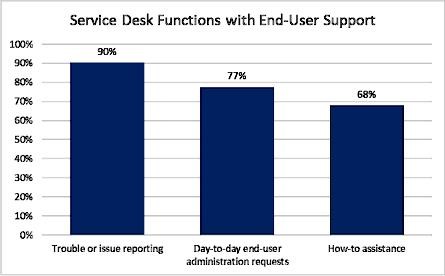 When we surveyed our members about the main capabilities specifically provided within the Service Desk that include end user support, service requests make up the second and third most prevalent functions supported as noted in the chart to the left.
When we surveyed our members about the main capabilities specifically provided within the Service Desk that include end user support, service requests make up the second and third most prevalent functions supported as noted in the chart to the left.
So, we see that when managed service offerings include end user support, the function of a Service Desk includes significant support for service requests from end users. Service requests require different skills, resources and processes than incident handling, problem management and escalations. And especially at scale, handling these requests efficiently is going to matter to the bottom-line performance of your business.
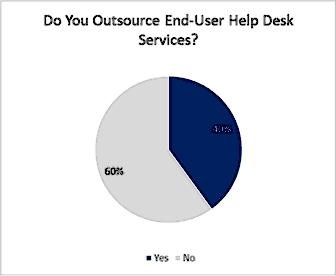 We should also note that many TSIA members opt to outsource this function to third-party providers rather than perform this function themselves as indicated in the chart to the right.
We should also note that many TSIA members opt to outsource this function to third-party providers rather than perform this function themselves as indicated in the chart to the right.
If these types of functions lie outside of your normal capabilities, it’s not difficult to find any number of capable service organizations that are ready to partner with you today to support this function. Partnering for delivery of managed services is a majority practice with 54 percent of our benchmarked members reporting outsourcing some part of their service delivery.
Why You Should Include End-User Help Desk Within Your Managed Services Offering
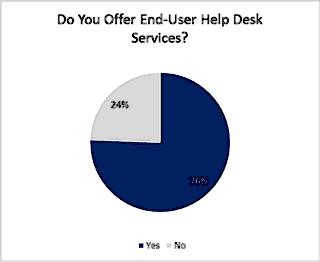 Within your Managed Services practice today, do you provide End-User Help Desk services directly to your customers’ end user population? Seventy-six percent of our survey respondents do as noted in the chart to the left.
Within your Managed Services practice today, do you provide End-User Help Desk services directly to your customers’ end user population? Seventy-six percent of our survey respondents do as noted in the chart to the left.
The message here is clear—if you’re not offering this capability in your portfolio, there are plenty of other providers that do.
Do you frequently get requests to include end user support capabilities within the scope of your managed services agreements, but turn away from these requests because this type of support is not “core” to your business or is not perceived as “critical”, scalable or particularly lucrative? 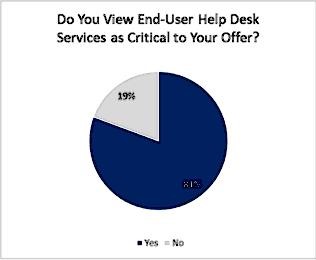 Eighty-one percent of our survey respondent view these capabilities as a critical part of their managed services offer (see chart to the right)
Eighty-one percent of our survey respondent view these capabilities as a critical part of their managed services offer (see chart to the right)
In the field, customer demand is driving members to offer these capabilities, with surveyed members reporting over 60 percent of customer engagements that include this function (see chart below).
What is driving customer demand for including end user support within managed services offerings? There is a drumbeat that is getting louder and louder in the technology marketplace. Customers are pressing their technology providers to deliver measurable business outcomes, not just whiz-bang technical capabilities. In Managed Services, we support delivering business outcomes by offloading the day-to-day administration of a technology to help customer organizations focus on the practice of utilizing that technology to its fullest potential within their business processes. If 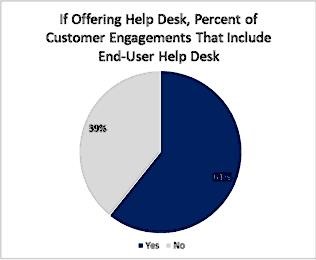 our service offerings only do part of the job, then we are part of the problem.
our service offerings only do part of the job, then we are part of the problem.
Providing services to end users provides a valuable route to gaining insight on how well your customers are actually utilizing and optimizing the technologies you support. By capturing information available directly from end users, you can not only gain better insight into the efficacy of your practice, you also can start collecting hard, measurable data on how your customers connect your service offers to business value. Among other benefits from this capability is that collecting business value data from your customers is the first step to moving toward value-based pricing models which are more defensible and less prone to competitive pricing pressure than standard, market-based service offerings.
Lastly, as with all components of technology services today, automation and digital transformation are driving significant change in End-User Help Desk functions, allowing providers to offer these capabilities more easily (through technology) and up-level their interactions with customers (from ITIL Foundation v4):
“With increased automation and the gradual removal of technical debt, the focus of the service desk is to provide support for ‘people and business’ rather than simply technical issues… [with] increased automation, AI, robotic process automation (RPA), and chatbots, service desks are moving to provide more self-service logging and resolution directly via online portals and mobile applications. The impact on service desks is reduced phone contact, less low-level work, and a greater ability to focus on excellent CX when personal contact is needed.”
End-User Help Desks Aids in Customer Success, Leading to Better Customer Relationships
If supporting end users was easy and scalable, everyone would be doing it. A quarter of those surveyed don’t support this function, and close to half of our surveyed members include this capability in their portfolio by sub-contracting to another vendor. Customers are asking providers to take over all, not some, of the responsibilities of supporting complex and integrated technologies, including how their users consume, adopt, and thrive with those technologies.
Supporting end users not only fills a current customer need, but also lays the groundwork for unlocking customer value through new data insights and interactions that improve customer experience and build a more robust Customer Success practice.
The data presented in this blog post is just a small snapshot of the vast vault of data TSIA has to offer members. From benchmarks to industry polls, we give you the fact-based insights you need to make real change within your organization. Contact TSIA today to receive information on the benefits of membership.
About The Author
Jeff Connolly is the senior director of managed services research for TSIA. He is a video and telecommunications industry veteran, with over 20 years of experience in managed services and Cloud delivery models. In his role at TSIA, Jeff provides members with fact-based education and insight into the performance and operations of managed services providers of all sizes.
